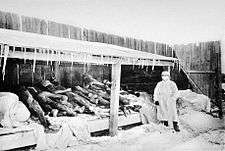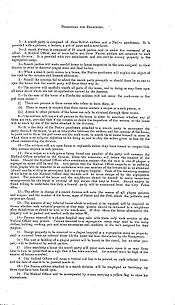Third plague pandemic

Third Pandemic is the designation of a major bubonic plague pandemic that began in Yunnan province in China in 1855.[1] This episode of bubonic plague spread to all inhabited continents, and ultimately more than 12 million people died in India and China, with 10 million people killed in India alone.[2] According to the World Health Organization, the pandemic was considered active until 1960, when worldwide casualties dropped to 200 per year.[3]
The name refers to this pandemic being the third major bubonic plague outbreak to affect European society. The first was the Plague of Justinian, which ravaged the Byzantine Empire and surrounding areas in 541 and 542. The second was the Black Death, which killed at least one third of Europe's population in a series of expanding waves of infection from 1346 to 1353.[4]
Casualty patterns indicate that waves of this late-19th-century/early-20th-century pandemic may have been from two different sources. The first was primarily bubonic and was carried around the world through ocean-going trade, through transporting infected persons, rats, and cargoes harboring fleas. The second, more virulent strain, was primarily pneumonic in character with a strong person-to-person contagion. This strain was largely confined to Asia, in particular Manchuria and Mongolia.
Pattern of the pandemic
The bubonic plague was endemic in populations of infected ground rodents in central Asia, and was a known cause of death among migrant and established human populations in that region for centuries. An influx of new people due to political conflicts and global trade led to the distribution of this disease throughout the world.
Origin in Yunnan Province of China
A natural reservoir or nidus for plague is located in western Yunnan and is an ongoing health risk today. The third pandemic of plague originated in this area after a rapid influx of Han Chinese to exploit the demand for minerals, primarily copper, in the latter half of the eighteenth century.[5] By 1850, the population had exploded to over 7 million people. Increasing transportation throughout the region brought people in contact with plague-infected fleas, the primary vector between the yellow-breasted rat (Rattus flavipectus) and humans. People brought the fleas and rats back into growing urban areas, where small outbreaks sometimes reached epidemic proportions. The plague spread further after disputes between Han Chinese and Hui Muslim miners in the early 1850s erupted into a violent uprising known as the Panthay rebellion, which led to further displacements (troop movements and refugee migrations). The outbreak of the plague helped recruit people into the Taiping Rebellion. In the latter half of the nineteenth century the plague began to appear in Guangxi and Guangdong provinces, Hainan Island, and later the Pearl River delta including Canton and Hong Kong. While William McNeil and others thought that the plague was brought from the interior to the coastal regions by troops returning from battles against the Muslim rebels, Benedict suggests that the evidence favors the growing and lucrative opium trade that began after about 1840.[5]
In the city of Canton, beginning in March 1894, the disease killed 60,000 people in a few weeks. Daily water-traffic with the nearby city of Hong Kong rapidly spread the plague. Within two months, after 100,000 deaths, the death rates dropped below epidemic rates, although the disease continued to be endemic in Hong Kong until 1929.[6]
Political impact in colonial India

Plague came to British India in 1896, most likely from Hong Kong where the epidemic had been festering since 1894. Over the next thirty years, the country would lose 12.5 million people to the disease. Almost all cases were bubonic, with only a very small percentage changing to pneumonic plague. (Orent, p. 185) The disease was initially seen in port cities, beginning with Bombay (now Mumbai), but later emerged in Pune, Kolkata, and Karachi (now in Pakistan). By 1899, the outbreak spread to smaller communities and rural areas in many regions of India. Overall, the impact of plague epidemics was greatest in western and northern India—in the provinces then designated as Bombay, Punjab, and the United Provinces—while eastern and southern India were not as badly affected.
The colonial government's measures to control the disease included quarantine, isolation camps, travel restrictions and the exclusion of India's traditional medical practices. Restrictions on the populations of the coastal cities were established by Special Plague Committees with overreaching powers, and enforced by the British military. Indians found these measures culturally intrusive and, in general, repressive and tyrannical. Government strategies of plague control underwent significant changes during 1898–1899. By that time, it was apparent that the use of force in enforcing plague regulations was proving counter-productive and, now that the plague had spread to rural areas, enforcement in larger geographic areas would be impossible. At this time, British health officials began to press for widespread vaccination using Waldemar Haffkine’s plague vaccine, although the government stressed that inoculation was not compulsory. British authorities also authorized the inclusion of practitioners of indigenous systems of medicine into plague prevention programs.
Repressive government actions to control the plague led the Pune nationalists to criticise the government publicly. On 22 June 1897, the Chapekar brothers, young Pune Hindus, shot and killed Walter Charles Rand, an Indian Civil Services officer acting as Pune Special Plague Committee chairman, and his military escort, Lieutenant Ayerst. The action of the Chapekars was seen as terrorism.[7] The government also found the nationalist press guilty of incitement. Independence activist Bal Gangadhar Tilak was charged with sedition for his writings as editor of the Kesari newspaper. He was sentenced to eighteen months rigorous imprisonment.
Public reaction to the health measures enacted by the British Indian state ultimately revealed the political constraints of medical intervention in the country. These experiences were formative in the development of India's modern public health services.
Global distribution
The network of global shipping ensured the widespread distribution of the disease over the next few decades.[8][9][10] Recorded outbreaks include:
- Pakhoi, China 1882.
- Canton, China 1894.
- Hong Kong 1894.
- Taiwan, Japan 1896.
- Bombay Presidency, India 1896–1898.
- Calcutta, India 1898.
- Madagascar, 1898.
- Egypt, 1899.
- Manchuria, China 1899.
- Paraguay, 1899.
- South Africa, 1899–1902.
- Territory of Hawaii, 1899.[11][12]
- San Francisco, United States, 1900.[13][14][15]
- Australia, 1900–1905.
- Russian Empire/Soviet Union, 1900–1927.
- Fukien Province, China 1901.
- Siam, 1904.
- Burma, 1905.
- Tunisia, 1907.
- Trinidad, Venezuela, Peru and Ecuador, 1908.
- Bolivia and Brazil, 1908.
- Cuba and Puerto Rico, 1912.
Each of these areas, as well as Great Britain, France, and other areas of Europe, continued to experience plague outbreaks and casualties until the 1960s. The last significant outbreak of plague associated with the pandemic occurred in Peru and Argentina in 1945.
Disease research
Researchers working in Asia during the "Third Pandemic" identified plague vectors and the plague bacillus. In 1894, in Hong Kong, Swiss-born French bacteriologist Alexandre Yersin isolated the responsible bacterium (Yersinia pestis) and determined the common mode of transmission. In 1898, French researcher Paul-Louis Simond demonstrated the role of fleas as a vector.
The disease is caused by a bacterium usually transmitted by the bite of fleas from an infected host, often a black rat. The bacteria are transferred from the blood of infected rats to the rat flea (Xenopsylla cheopsis). The bacillus multiplies in the stomach of the flea, blocking it. When the flea next bites a mammal, the consumed blood is regurgitated along with the bacillus into the bloodstream of the bitten animal. Any serious outbreak of plague in humans is preceded by an outbreak in the rodent population. During the outbreak, infected fleas that have lost their normal rodent hosts seek other sources of blood. The bacterium that causes this disease, Yersinia pestis, was named after Yersin. His discoveries led in time to modern treatment methods, including insecticides, the use of antibiotics and eventually plague vaccines.
The British colonial government in India pressed medical researcher Waldemar Haffkine to develop a plague vaccine. After three months of persistent work with a limited staff, a form for human trials was ready. On January 10, 1897 Haffkine tested it on himself. After the initial test was reported to the authorities, volunteers at the Byculla jail were used in a control test, all inoculated prisoners survived the epidemics, while seven inmates of the control group died. By the turn of the century, the number of inoculees in India alone reached four million. Haffkine was appointed the Director of the Plague Laboratory (now called Haffkine Institute) in Bombay.[16]
See also
References
- ↑ Cohn, Samuel K. (2003). The Black Death Transformed: Disease and Culture in Early Renaissance Europe. A Hodder Arnold. p. 336. ISBN 0-340-70646-5.
- ↑ Infectious Diseases: Plague Through History, sciencemag.org
- ↑ ListVerse.com (2009-11-03). The Ultimate Book of Top Ten Lists: A Mind-Boggling Collection of Fun, Fascinating and Bizarre Facts on Movies, Music, Sports, Crime, Ce. Ulysses Press. ISBN 9781569758007.
- ↑ Nicholas Wade (October 31, 2010). "Europe's Plagues Came From China, Study Finds". The New York Times. Retrieved 2010-11-01.
The great waves of plague that twice devastated Europe and changed the course of history had their origins in China, a team of medical geneticists reported Sunday, as did a third plague outbreak that struck less harmfully in the 19th century.
- 1 2 Benedict, Carol (1996). Bubonic plague in nineteenth-century China. Stanford, Calif.: Stanford Univ. Press. pp. 47, 70. ISBN 978-0804726610.
- ↑ Pryor, E.G. (1975). "The Great Plague of Hong Kong". Journal of the Hong Kong Branch of the Royal Asiatic Society.: 69.
- ↑ Zaman, Rashed Uz (2013). "Bengal terrorism and the ambiguity of the Bengali Muslims". In Jussi H. Nhimaki; Bernhard Blemenau; Jussi Hanhim Ki. An International History of Terrorism: Western and Non-western Experiences. Routledge. p. 152. ISBN 0415635403.
- ↑ Low, Bruce (1899). "Report upon the Progress and Diffusion of Bubonic Plague from 1879 to 1898". Reports of the Medical Officer of the Privy Council and Local Government Board, Annual Report, 1898-99. London: Darling & Son, Ltd. on behalf of His Majesty's Stationery Office: 199–258. Retrieved 17 October 2010.
- ↑ Low, Bruce (1902). "Summary of the Progress and Diffusion of the Plague in 1900". Reports of the Medical Officer of the Privy Council and Local Government Board, Annual Report, 1900-01. London: Darling & Son, Ltd. on behalf of His Majesty's Stationery Office: 264–282. Retrieved 17 October 2010.
- ↑ Eager, J.M. (1908). "The Present Pandemic of Plague". Public Health Bulletin. Washington: Government Printing Office: 436–443. Retrieved 17 October 2010.
- ↑ "Honolulu's Battle with Bubonic Plague". Hawaiian Almanac and Annual. Honolulu: Thos. G. Thrum, Hawaiian Gazette Co.: 97–105 1900. Retrieved 17 October 2010.
- ↑ https://scholarsbank.uoregon.edu/xmlui/bitstream/handle/1794/7694/Bailey_Kevin_thesis2007.pdf?sequence=1
- ↑ "On The Plague In San Francisco". Journal of the American Medical Association. Chicago: The American Medical Association. 36 (15): 1042. April 13, 1901. doi:10.1001/jama.1901.52470150038003. Retrieved 17 October 2010.
- ↑ "The Plague, "American Medicine," And The "Philadelphia Medical Journal."". Occidental Medical Times. San Francisco: Occidental Medical Times. 15: 171–179. 1901. Retrieved 17 October 2010.
- ↑ "Bubonic Plague At San Francisco, Cal". Annual Report of the Supervising Surgeon General of the Marine Hospital Service of the United States for the Fiscal Year 1901. Washington: Government Printing Office: 491–. 1901. Retrieved 17 October 2010.
- ↑ Hanhart, Joel (2016). Waldemar Mordekhaï Haffkine (1860-1930). Biographie intellectuelle,. Paris: Honore Champion.
Further reading

- Advisory Committee for Plague Investigations in India (1911), Report On Plague Investigations In India, 1906-1910
- Gandhi, M. K. The Plague Panic in South Africa
- Gregg, Charles. Plague: An Ancients Disease in the Twentieth Century. Albuquerque, University of New Mexico Press, 1985.
- Kelly, John. The Great Mortality: An Intimate History of the Black Death, the Most Devastating Plague of All Time. New York: HarperCollins Publishers, 2005. ISBN 0-06-000692-7.
- McNeill, William H. Plagues and People. New York: Anchor Books, 1976. ISBN 0-385-12122-9.
- Orent, Wendy. Plague: The Mysterious Past and Terrifying Future of the World's Most Dangerous Disease. New York: Free Press, 2004. ISBN 0-7432-3685-8.